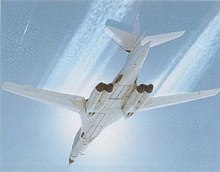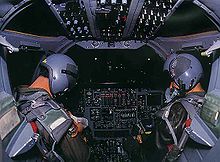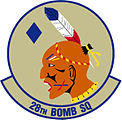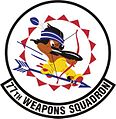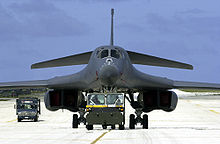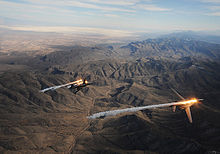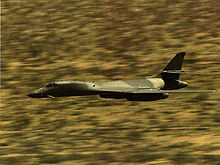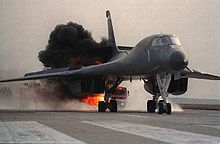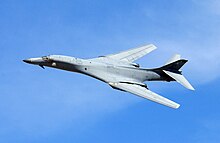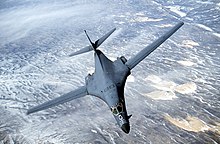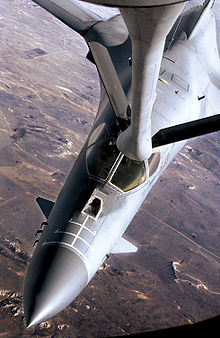Rockwell B-1
| Rockwell B-1 Lancer | |
|---|---|
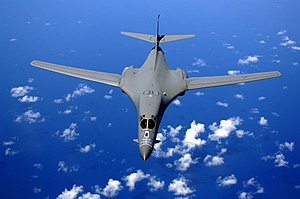 A B-1B "Lancer" over the Pacific Ocean |
|
| Type: | Strategic bomber |
| Design country: | |
| Manufacturer: |
Rockwell International until 1996 , |
| First flight: |
December 23, 1974 (B-1A) |
| Commissioning: |
October 1, 1986 |
| Production time: |
Early 1970s to 1988 |
| Number of pieces: |
104 |
The Rockwell B-1 Lancer ("Lancier"), also known as the Boeing B-1 since Rockwell International was acquired by Boeing , is a supersonic , long-range strategic bomber that has been in service by the United States Air Force since 1986. Development of the aircraft began in the mid-1960s, but the B-1A was never put into service and the project was halted in 1977. It was not until 1981 that the old plans were taken up again and modified into today's B-1B Lancer . The first machines were taken over in 1986 and flew missions over Yugoslavia , Afghanistan and Iraq , among others . The pivoting wings are an essential external feature of the aircraft .
history
planning
In the early 1960s, the United States Air Force was looking for a successor to the Boeing B-52 bomber after Robert McNamara ended the XB-70 program in 1961. 1962 began the conception of the so-called Supersonic Low Altitude Bomber ( English for supersonic low-altitude bomber ). A year later, under the code name Project Forecast a strategy planning, which the usefulness of manned bombers compared to sea- and land-based intercontinental ballistic missiles should assess. The usefulness of the bombers was confirmed above all because of the possibility of revoking a mission order once given, and so four programs for planning a bomber were launched, namely Extended Range Strategic Aircraft ( English for strategic aircraft with improved range ), Low Altitude Manned Penetrator , Advanced Manned Penetrator and Advanced Manned Penetrating Strategic System . From that developed in 1965 Advanced Manned Strategic Aircraft (AMSA) ( English for Advanced Manned Strategic Aircraft ), where the aircraft manufacturer Boeing, North American Rockwell and General Dynamics were involved. This project was supposed to produce a bomber that could reach enemy airspace through enemy air defense , which was to be achieved primarily by high-speed flights at low altitudes.
The idea of the inviolability of high-flying bombers had already proven outdated in the early 1960s. The shooting down of Francis Gary Powers ' Lockheed U-2 in 1960 over the Soviet Union showed that altitude alone was no longer a protection against anti-aircraft missiles . Rather, the future manned bomber had to reach its target low-flying to avoid the radar . Finally, in late 1969, the Air Force called on the industry to come up with specific designs for such a bomber. In June 1970, Rockwell's proposal was accepted and a contract for five B-1 prototypes was signed, which was reduced to four planes a short time later.
Test flights
After some changes to the original appearance and especially to the avionics initiated by the Air Force (after the mock-up was evaluated in October 1971, there were a total of 297 officially recorded change requests) , production of the first B-1A began in Rockwell's plant in Palmdale , California . The rollout of the machine with the number 74-0158 took place on October 26, 1974, about a year after the planned date. The first flight on December 23, 1974 lasted 78 minutes and led the B-1 to Edwards Air Force Base . In the following months there were further test flights, on April 10, 1975 the aircraft broke the sound barrier for the first time . The second machine ( 74-0159 ) was mainly tested on the ground, while the third ( 74-0160 ) had its maiden flight shortly after the rollout on April 1, 1976. 74-0159 took off for the first time on June 14th and from then on took part in flight tests in Edwards.
The end for the B-1A
On 1 December 1976, the recommended Defense System Acquisition Review Council ( English for advice to clarify the procurement of defense technology ) initially the purchase of 244 bombers, the costs have been committed in the budget 1978th In the course of the SALT arms limitation talks , the Pentagon reduced this number to 150 six months later. When it finally became known that the budget of 100 million US dollars per unit would be blown, the then US President Jimmy Carter declared on 30. June 1977 the end for the B-1A; on July 6th the contracts were terminated. This is attributed not only to the high costs and disarmament talks, but also to the emergence of air-launched cruise missiles that could perform the tasks of the B-1 without exposing pilots and valuable machines to enemy fire.
According to Ben Rich , the head of the Lockheed Skunk Works at the time , there was another important reason which, due to secrecy, would only become known later. 1977 was also the year in which the top secret Lockheed Have Blue flew for the first time. It was the breakthrough in the development of stealth aircraft , which resulted in the first secret entry into service of the first F-117 stealth fighter aircraft in the 1980s . After being notified of these advances by Lockheed, the Carter administration could not allow billions of dollars to be poured into obsolete technology to introduce a new strategic bomber. The B-1A would have had a far too low chance of survival if it had entered a well-defended airspace, while a stealth bomber seemed almost invulnerable in this regard. In 1979 the United States began developing that stealth bomber: Advanced Technology Bomber (ATB), later known as the Northrop B-2 .
Continuation as a research program
Despite the formal end of production of the B-1A, test flights of the prototypes and the construction of the fourth machine, which had already started, continued as part of a research and development program. The fourth model (76-0174) finally took off for the first time on February 14, 1979. In October of the previous year, the second prototype set a new speed record for the B-1 with Mach 2.2. When the research program ended in April 1981, the four aircraft had completed nearly 1,900 flight hours in 350 flights.
The B-1B goes into series production

From 1980, the Air Force was looking for a new generation of bombers that could replace the B-52. After several alternatives had been discarded, the new US President Ronald Reagan finally announced on October 2, 1981 that the Air Force would receive 100 models of a revised B-1, known as the B-1B. Outwardly very similar to the B-1A, the profile of the B-1 in particular had changed: It was intended as a low-level bomber ; For greater payload and range, speed was sacrificed - in addition, new knowledge of stealth technology was incorporated into the design of the B-1B . The first operational models were to be delivered in 1986. Outwardly almost unchanged, the maximum weapon load was increased and the avionics improved. The radical simplification of the engine intakes can hardly be seen. While an elaborate adjustment system was used on the B-1A in order to supply the engines in the wide flight envelope with sufficient combustion air, the entire adjustment mechanism on the B-1B was removed and replaced by a simple S-shaped inlet, which was only up to can be used at a low supersonic speed. The S-shaped inlet prevents a direct view of the front compressor blades of the engine. Together with radar-absorbing coatings, this ensures that penetrating radar beams are dead and are not reflected.
For this purpose, the B-1A prototypes No. 2 and 4 were converted to B-1B prototypes, but 74-0159 (prototype 2) was lost on August 29, 1984 when the crew overridden the fuel supply computer while pivoting the wings and the This shifted the center of gravity out of the permissible range. The machine was unable to fly and crashed. Rockwell's chief pilot Doug Benefield lost his life because the escape pod was blown off with the crew, but the parachute system did not work properly. The accident had little effect on the program, however, as the first “real” B-1B ( 82-0001 ) had its rollout on September 4, 1984 and was able to take off on its maiden flight six weeks later.
The two remaining B-1A prototypes are now in the Strategic Air and Space Museum in Ashland , Nebraska and the Wings Over the Rockies Air and Space Museum in Denver , Colorado .
construction
On January 20, 1988, the USAF signed the contract for the series production of the B-1B with the manufacturer Rockwell International . A total of 100 B-1Bs were built, priced around $ 200 million each. With a total budget of US $ 20 billion, the program was the Air Force's most cost-intensive program to date. This is particularly noteworthy because the production of the Northrop B-2 had already been decided and the B-1B was only to serve as an interim solution. The B-1 was built in Palmdale, with Rockwell doing about 60% of the work and subcontracting the rest. This led to the allegation that the draft could only have passed the US Congress because many MPs promised supplier contracts for companies in their constituencies.
Present and Future

From 1995, twelve B-1B were withdrawn from service the Air Force and the Air National Guard of Georgia and Kansas allocated. In 2002 these associations were disbanded and the bombers returned to the command of the Air Force.
With 93 units still active (the rest of the bombers were lost in accidents) at the turn of the millennium, the Air Force's cost of maintaining the fleet was too high. From 2002 a total of 24 units were therefore stored in the Aerospace Maintenance and Regeneration Center in order to be able to use the money saved for modernization projects . Ten of the aircraft were preserved, the remaining 14 were released for canning as spare parts suppliers. Eight units were decommissioned in addition to the exhibition in museums. When the remaining 60 bombers performed well over Afghanistan and Iraq, it was decided to reassign seven of the inactive aircraft to the active fleet.
In September 2016, 62 machines were still in active service. In May 2006, a B-1B was exhibited for the first time at the International Aerospace Exhibition (ILA) in Berlin.
Because a concept for a new strategic bomber (B-3) only exists in the early stages, the fleet of B-1 bombers will possibly remain in the arsenal well into the 21st century, along with the still active B-52H and the small number of B-2A Spirit built form the entire long-range bomber fleet. The Air Force plans to keep the number of active B-1s at the current level of over 60 units by 2037. Projections from 1999 show that the end of the service life of the fastest wearing parts, whose replacement is uneconomical , will be reached in 2038 at the current low level of utilization .
In October 2015, Northrop Grumman received an order to develop a new long-range bomber B-21 Raider ( LRS-B ), which will replace both the B-1B and the B-52 from 2025. Here, the ability to fly supersonic was given up in favor of better stealth properties.
crew
The B-1B is flown by four crew members seated on ACES II ejection seats. A hatch is blown open over the seats when getting out. In the B-1A, the rescue system still consisted of a detonable capsule that separated the entire cockpit from the fuselage and parachuted it to the ground. This system was abandoned because individual ejection seats were found to be more reliable and were both cheaper and lighter. The entry into the bomber is via a ladder that is located directly behind the bow chassis . The cockpit and the cabin for the "system officers" are separated by a corridor, and there is a chemical toilet between the two cabins .
The pilot , who is also the commander, and his co-pilot sit next to each other in the cockpit . The Defensive System Officer (DSO) and the Offensive System Officer (OSO) sit in a separate cabin at the rear. The OSO sits on the right and is responsible for the radar system , navigation and bombing. The DSO on the left controls the jamming systems and is responsible for deploying the radar and infrared decoys ( Chaffs , Flares ).
The crews rarely refer to the bomber with the official nickname Lancer ( English for Ulan ), but more common is bone due to an earlier typographical error with a missing hyphen ( BONE ).
units
USAF B-1 bases |
Currently (as of February 2012), two US Air Force squadrons, each with two squadrons and two individual squadrons, are using the B-1. Locations are Dyess Air Force Base in Abilene (Tailcode DY ), Texas and Ellsworth Air Force Base in Rapid City in South Dakota (Tailcode EL ):
Dyess Air Force Base
- 7th Bomb Wing:
- 9th Bomb Squadron
- 28th Bomb Squadron
- 77th Weapons Squadron
- 337th Test and Evaluation Squadron
Ellsworth Air Force Base
- 28th bomb wing
- 34th Bomb Squadron
- 37th Bomb Squadron
The four squadrons of the bomber squadron are operational squadrons that can be relocated to crisis areas, the 337th Test and Evaluation Squadron carries out the training of the crews. All squadrons have been subordinate to the Air Force Global Strike Command (AFGSC) since October 2015 .
technology
hull
The body of the B-1B has a length of 44.81 meters and consists mainly of aluminum - and titanium alloys as well as glass fiber - composite materials . Radar-absorbing material was used on the fuselage flaps, the wing root fairings and the engine inlets, which does not reflect the incident radar rays, but absorbs them.
In front of the cockpit, the small canard- like auxiliary control surfaces of the automatic gust suppression system are attached to the nose of the fuselage , which compensate for gusts of wind in low flight and thus ensure a smoother flight, which also leads to less structural stress. There are seven-part slats and six-part lift flaps on the swiveling wings , which are also controlled as ailerons . The wing area is 181.2 m².
The swing wings have a wingspan of 23.84 meters at the maximum sweep of 67.5 °. This sweep is used on high-speed and low-level flights to reduce drag and gust load. The minimum sweep of 15 ° corresponds to a wingspan of 41.67 meters and is used for take-off and landing as well as for economy flights. The flaps can only be used if the arrows are below 20 °. Other possible angles are 25 °, 45 ° and 55 °. A change of the arrow changes the position of the lift point ; In order not to move it too far from the aircraft's center of gravity, the trim is automatically adjusted by pumping fuel into other tanks .
The vertical stabilizer is 10.36 meters high, the horizontal stabilizer , designed as a pendulum rudder, is about 13 meters wide. The elevators and rudders are attached above the actual fuselage.
The landing gear consists of a double wheel at the bow and two landing gear supports with four wheels each at the rear. The nose landing gear retracts forwards in full length. The main landing gear is retracted to the rear and towards the center in two bays between the engine nacelles.
drive
The four turbofan engines of the type General Electric F101-GE-102 are available in two gondolas outside of the airframe mounted. They each deliver 64.94 kilonewtons of thrust “dry” and 136.92 kN with an afterburner . When using the afterburner, the B-1B reaches speeds of Mach 1.2 (1,328 km / h) at high altitudes or Mach 0.95 (1,120 km / h) at low altitude. The maximum take-off weight is 216 t. In order to reduce the bomber's radar signature , the air intakes of the engines are designed in such a way that enemy radar cannot directly reach the engine's compressor blades , which significantly reduces the echo and makes identification more difficult.
The engines use three generators with an output of 115 kVA each to generate electricity to operate the electrical devices on board. About two on-board auxiliary power units ( "Auxiliary Power Units"), a B-1 can also be used by advanced bases without infrastructure. In the event of an alarm start, these can be started using a switch on the nose landing gear so that they are already in operation when the crew takes their seats.
Approximately 166,000 liters of fuel can be carried in the inner tanks, which enables a range of around 12,000 km. In addition, each of the three weapon bays can accommodate an additional tank with a capacity of 11,500 liters. Another six tanks with a capacity of 3,500 liters each can be attached externally. This means that the B-1B can carry a maximum of 221,500 liters of fuel. The B-1 can also be refueled in the air . The filler neck required for this is located on the nose in front of the cockpit windows.
Avionics

The AN / APQ-164 radar device (manufacturer: Westinghouse Electric ) is located in the nose of the B1 bomber. It is a radar system with passive electronic beam swiveling , which, due to the reduced unwanted emission of radar power, significantly reduces the detectability compared to normal radar devices . The radar is suitable for target search , target tracking , weapon control and terrain tracking and can also be used as an imaging synthetic aperture radar . The navigation takes place via an inertial navigation system , with newer versions also via the Global Positioning System .
The defensive avionics on board consist of the AN / ALQ-161 from Eaton Corporation . The system includes radar detectors and jammers with which the DSO can track down radar beams from enemy aircraft and ground stations and then jam them - specially tailored to the radar device. The sensors for this are installed in the tail and in the wing roots so that 360 ° coverage is guaranteed. A disruptive body can be dragged behind the aircraft against approaching missiles, which provides a target for the attacking missile and thus deflects the missile from the bomber ( AN / ALE-50 ). The entire ALQ-161 system weighs (without operating elements) around 2,500 kg and requires an electrical output of 120 kW in operation.
In 2009, the retrofitting of the "Fully Integrated Data Link" communication system began, which extends the Link 16 standard with a protocol for satellite communication . The Sniper ATP is currently also being integrated into the B-1B fleet. It is an external container that can capture, identify, and track ground targets with a FLIR or image sensor to provide target data for precision-guided bombs .
Armament
The maximum weapon load of the B-1B is almost twice as high as that of the B-52 at 60,781 kg; The B-1B carries up to 34,019 kg of its weapons in three internal weapon bays, in which it can transport both free-falling bombs and precision-guided ammunition in revolver magazines. Each of the magazines has a capacity of 28 500 pound bomb of the type Mk 82nd or 30 cluster bombs or 12 Mk.-65 - mines . As precision ammunition, 30 cluster bombs with wind correction (WCMD: Wind Corrected Munitions Dispenser) or 24 bombs upgraded using Joint Direct Attack Munition (JDAM) can be carried (since modernization from 1998) , alternatively 24 GBU-27 Paveway - or 12 AGM - 154 Joint Standoff Weapon ( JSOW ) glide bombs. In addition, up to 24 cruise missiles of the type AGM-158 JASSM be carried.
The use of the six external suspensions was forbidden by the START disarmament treaty until 2002 , as was the theoretically possible carrying of nuclear bombs and missiles, such as the AGM-69 SRAM , in the weapons bay. Since the termination of START, the Air Force has been working on using the externally mounted Sniper Advanced Targeting Pod system, which provides the crew with enhanced targeting data, in addition to the F-15, F-16, and the A-10 on the B-1 to be able to. It has been operational since summer 2008 and was first used in Afghanistan in August 2008. Weapons attached to the external load carriers increase the radar cross-section and thus the visibility of the bomber to enemy radar. This renders the design measures that were taken to reduce radar visibility largely ineffective and therefore represents an operational restriction.
Self-protection systems
Since one did not want to rely solely on the camouflaging properties of the B-1B, it is equipped with additional active jamming systems. With the AN / ALQ-161, a system specially tailored to the machine was developed for this purpose. With a weight of 2.5 tons and over 120 modules, it is one of the most powerful self-protection systems of its kind and is designed to interfere with even the most powerful radar systems, which is made even easier by the machine's small radar cross-section. Individual components of the system are regularly modernized, but a complete renewal was not implemented for budget reasons.
In addition, the B-1B has eight AN / ALE-49 - Dispenser for twelve MJU-23 A / B Infrarottäuschkörper . With a gross mass of 1,770 g, the MJU-23-A / B decoys is one of the world's largest pyrotechnic decoy targets . The cylindrical active charge made of magnesium / Teflon / Viton alone weighs around 1,474 g. In contrast to other western platforms, the dispensers are attached to the top of the bomber behind the cockpit and thus allow it to be fired upwards. A similar attachment of the decoy dispenser is known from aircraft of the former Warsaw Pact such as the MiG-29 or Su-27 .
An AN / ALQ-153 Doppler radar is also installed at the stern , which warns the crew of guided missiles and aircraft approaching from behind , even if they do not emit radar emissions.
An AN / ALE-50 system has also been retrofitted at the rear . In the event of danger from radar-guided weapons, an active decoy is ejected on a cable several hundred meters long, which is then towed behind the machine. This actively enlarges its own radar signature, so that it is a larger and more attractive target as a bait than the B-1B itself, effectively deflecting approaching guided missiles.
For passive protection were four radar warning sensors of the type AN / ALR-56M installed.
Records
The B-1 set a number of official and unofficial world records; she was also able to win several awards. This began in 1976 when the National Aeronautic Association - the American branch of the Fédération Aéronautique Internationale - awarded the B-1A project team the Robert J. Collier Trophy , which is awarded annually for the greatest achievements in the American aviation community. After the B-1B went into service in 1987, it set several world records for speed, distance and payload. On July 4, Freedom Flight I took place, in which a B-1B off the Pacific coast of California covered 2000 kilometers with a 30 t payload at an average speed of Mach 0.9, breaking four existing records (over 1000 and 2000 km) and 14 new ones put up. On September 17, 86-0110 broke another nine records during Freedom Flight II over the distance of 5000 kilometers with a payload of 30 t and also set nine new ones. For these flights, the B-1B fleet received the Mackay Trophy , which is awarded annually to the "most recognizable flight of the year".
On February 27 and 28 and on March 18, 1992, a total of three B-1B set new records for climbing performance. The machines with a payload of 10 t rose to a height of 3000 meters in 1:13 minutes (measured from the time the brakes were released on the ground) and to 12,000 meters in 5:02 minutes. With a payload of 30 t, a B-1B needed 9:42 minutes for this altitude.
On June 2, 1995, two B-1Bs with a payload of 15 t took off from Dyess AFB in Texas and flew eastwards across the Atlantic. On the flight over Italy, the planes bombed training targets on the Pachino Range in Italy and continued their flight over the Indian Ocean towards Japan, where they again bombed targets near Kadena Air Base on Okinawa . From there, the B-1 flew further east to Texas, attacking training targets in Utah . The entire flight lasted 36 hours, 13 minutes and 36 seconds. On the 20,100 mile flight, the units were refueled six times; With an average speed of 1168 km / h, the bombers set new speed records in the open class (without weight limit), for which the crews were awarded the Mackay Trophy .
In 2003, a B-1B set almost 50 new world speed records in its FAI class (C-1, Group 3) at the Edwards Air Force Base Open House and Air Show , here over distances of 3, 15, 25, 100, 250 and 1000 kilometers.
In addition, in March 2008, the B-1B was the first USAF aircraft to fly at supersonic speed on synthetic fuel.
Modifications
B-1B
The so-called Conventional Mission Upgrade Program (CMUP) was financed with 2.7 billion dollars from the 1993 budget. The aim was to equip the B-1B in accordance with the START II regulations so that it could no longer carry nuclear cargo (START II, however, allows the bombers to be converted back into nuclear weapons after a 90-day notice period). This happened in several stages, the blocks .
- Block A
- Block A denotes the standard version of the B-1B, with only the ability to transport free-fall bombs of the type Mk. 82 in addition to nuclear weapons .
- Block B
- In Block B, which was installed in 1995, the radar was improved, and the electronic countermeasures were updated to a new version.
- Block C
- Block C, first deployed in September 1996 and declared operational in 1997, added support for cluster bombs.
- Block D
- Block D allowed the crew of the B-1B to drop precision bombs equipped with Joint Direct Attack Ammunition (JDAM) . ALE-50 was also installed. Unit D was operational on the first machines from December 1998. From this block onwards, a receiver of the Global Positioning System supported the inertial navigation system for navigation. As of spring 2004, all machines were converted to block D.
- Blocks
- Block E included improvements to the avionics so that JSOW and WCMD can be fired. Block E also introduced the ability to carry different types of ammunition at the same time.
- Block F
- Block F describes the planned improvement of the bombers' defense systems. Among other things, the towed decoy should be upgraded to an improved version, the defensive systems upgrade program should also modify the radar detectors and replace the AN / ALQ-161 with the more reliable AN / ALR-56 M and AN / ALQ-214 systems become. However, due to high costs, the entire block was canceled in December 2002.
B-1R
A concept proposed by Boeing to extensively modify the aircraft goes under the name B-1R and was featured in Air Force Magazine in November 2004 . The R stands for regional . The new " Active Electronically Scanned Array " radar should then also allow the aircraft to conduct air-to-air warfare , and the external weapon mounts would also be given the option of dropping conventional weapons. This would significantly increase the payload of the bomber and would be useful in a war, especially after the enemy air defense has been destroyed, when the importance of the radar cross-section takes a back seat to the payload.
In addition, the engines are to be exchanged for those of the F-22 Raptor ( Pratt & Whitney F119 -PW-100), which, in addition to the ability to supercruise with the afterburner, can also reach Mach 2.2. The new engines would reduce the operational range by around 20%. For this reason, the bomber should also be assigned more regional tasks. Deep penetration into enemy air space, as would have been necessary due to the geographic conditions against the Soviet Union, will no longer be possible, since air refueling over enemy territory is of course not possible. But since block states territories like those of the Warsaw Pact no longer exist, Boeing assumes that the bomber can reach all targets even with a smaller range by refueling directly at the border of a potential enemy state.
Mission profile
The mission profile of the B-1A envisaged the penetration into the enemy airspace at low altitude with high subsonic speed, while the approach should take place either with supersonic or in economy flight at high altitude.
The B-1B is also designed to penetrate enemy airspace at low altitude. Low-level flight means flight following terrain down to 60 meters above the ground at speeds just below the sound limit . The radar cross section ( engl. Radar Cross Section, RCS ) is generally lower than that of a B-52. The exact RCS is unknown and depends on the angle of incidence . According to Janes's All The World's Aircraft, it is only about one hundredth of the RCS of the B-52. The GAO contradicted the information in part because the Department of Defense only passed on the values from the front, but a higher value can be expected from other angles. The engine nacelles, in particular, can be seen quite well by radar devices. At low altitudes, however, there is no time for a single SAM position to lock onto the target and launch a rocket before the aircraft disappears behind the radar horizon again .
Combat missions
The first combat mission of the B-1B was flown against targets in Iraq in 1998 during Operation Desert Fox . The bombers took off on a total of six flights; the attacks were aimed at barracks of the Republican Guard .
In 1999, six bombers were used in over 100 flights from RAF Fairford as part of Operation Allied Force during the Kosovo War. They dropped 20% of the total bomb load during 2% of the total flights.
In the following years, eight Diego Garcia B-1B flew missions over Afghanistan ( Operation Enduring Freedom ) , dropping 40% of the total bomb load in the first six months. These included 3,900 JDAM , two thirds of the drops of this type of ammunition. In 2003 the B-1 also took part in the Iraqi war operation Iraqi Freedom . They flew around 2% of all missions from Oman and dropped more than 50% of this type of ammunition with 2,100 JDAM . The main targets of the B-1 bombers also included administrative buildings in Baghdad , including the Ba'ath Party headquarters . On April 7, 2003, a block of houses in Baghdad with four JDAMs was attacked because, according to intelligence information, the Iraqi dictator Saddam Hussein was supposed to have hidden there. Twelve people were killed while the alleged information was not confirmed.
140 civilians were killed in a combat operation of a B-1B in the Afghan district of Bala Buluk on May 4, 2009 on suspected Taliban positions.
Before the air attack near Kunduz on September 4, 2009, a B-1B with Sniper-ATP cleared the region around the tanker trucks that were later bombed.
In March 2011, B-1 bombers from Ellsworth Air Force Base attacked targets in Libya as part of Operation Odyssey Dawn to enforce the no-fly zone under UN Security Council Resolution 1973 .
Since the US operation against the Islamic State (IS) terrorist militia began on August 8, 2014, B-1 bombers have been used to support allied ground forces. They flew from Al Udeid Air Base in Qatar. In February 2016 they were withdrawn to allow upgrades in the cockpit. Various squadrons were in use, rotating in a 6-month rhythm.
In the air strike on Damascus and Homs on April 14, 2018, two B-1Bs of the 34th Bomb Squadron took part, which fired 19 AGM-158A JASSM cruise missiles .
Incidents
September 1987
From the first flight in 1974 to July 2018, there were 10 total aircraft losses with the Rockwell B-1 Lancer. In 4 of them, 12 people were killed.
- The first B-1B to be lost was 84-0052 , based at Dyess Air Force Base. She had an accident in September 1987 on a training flight near La Junta , Colorado . During a low-level exercise, the machine collided with a rhinoceros pelican weighing 10 kilograms . Hydraulic, electrical and kerosene-carrying lines were cut in a wing root and a fire was triggered. Two instructors who were not in ejection seats and the copilot, whose ejection seat did not deploy, died when the plane crashed on the ground. The three other crew members survived. As a result, the Air Force reinforced parts of the bomber at risk of bird strikes.
- November 8, 1988
85-0063 had an accident on November 8, 1988 at Dyess Air Force Base when a fire broke out in the left wing during go-around training and the engines on this side had to be switched off. The crew was able to save themselves with an ejector seat. It is believed that fuel ignited on part of the cooling system.
- Just a few days later, 85-0076 had an accident at Ellsworth Air Force Base , when it touched several masts on approach about a kilometer from the base and fell. The crew managed to save themselves; the Air Force later announced that the pilots had neglected altitude control when planning the approach to landing in heavy cloud cover.
- November 30, 1992
On November 30, 1992, all four crew members of the 86-0106 were killed when their B-1B crashed into a ridge south of El Paso , Texas while flying low at night. According to the Air Force, the bomber was flying parallel to a ridge several dozen meters below the surrounding peaks as it turned towards the mountains. Since the pilot, the terrain-following radar ( "Terrain Following System") had turned off just before the plane hit, one starts from a human error.
- September 19, 1997
85-0078 had an accident on September 19, 1997 near Alzada, Montana , when the crew lost control of the aircraft during a low-altitude training maneuver. The flight recorder recorded that a crew member had pulled the thrust levers to idle and extended the airbrakes. The machine quickly lost speed and went into a spin, which the crew could not end due to the low altitude of around 600 feet. On board were two of the most experienced B-1 pilots in the USAF with over 8,000 hours of total flight experience and 2,000 hours on the B-1.
- February 18, 1998
On February 18, 1998, a short circuit occurred on board 84-0057 that switched off all four engines. The aircraft, whose engines could not be restarted in the air, crashed near Marion, Kentucky , and the crew were able to save themselves with their ejector seats.
- December 12, 2001
86-0114 (Type B-1B) crashed into the Indian Ocean on December 12, 2001 during a combat mission from Diego Garcia Island to Afghanistan . The reason remained unclear; malfunctions in the height measurement system were suspected. After some time, all four crew members were rescued by a destroyer of the Navy , the USS Russell (DDG-59) ; enemy fire was ruled out as a reason for the crash.
- December 30, 2004
The entire B-1 fleet was banned from take-off from December 30, 2004 to January 5, 2005 after the nose landing gear of one of the aircraft had buckled during landing. During the five days, the running gear was checked on all machines, but no defects were found.
- May 8, 2006
On May 8, 2006, a B-1B crashed while landing on Diego Garcia. Since the landing gear was not extended, the machine touched down with the fuselage. The co-pilot was slightly injured, the three other crew members were not injured. The USAF's investigation report attributes the error to the fact that the co-pilot was busy handling the aircraft and successfully completing the mission and incorrectly assumed that the pilot had extended the landing gear. The cockpit voice recorder showed that the landing checklist had not been read. There was nearly $ 8 million in damage to the aircraft and about $ 15,000 to the runway.
- April 4, 2008
On April 4, 2008, a B-1 of the 379th Air Expeditionary Wing was destroyed while taxiing after landing at Al Udeid Air Base in Qatar. When rolling, the machine's braking systems failed so that it could no longer be controlled. The machine then rammed a concrete wall behind which C-130 Hercules transport aircraft were parked; due to several leaks, the aircraft caught fire, which could only be extinguished the next day. The four crew members saved themselves over the back of the fuselage and were uninjured.
- 19th of August 2013
On August 19, 2013, a B-1B of the 28th Bomb Wing crashed near Broadus, Montana . The aircraft was on a training flight and was arriving from Ellsworth Air Force Base . The four crew members were able to save themselves with the ejection seat and were not injured.
Technical specifications
| Parameter | Data |
|---|---|
| crew | 2 pilots, 1 offensive systems officer, 1 defensive systems officer |
| length | 44.81 m |
| span |
Swiveled in: 23.84 m |
| Wing area | 181.2 m² |
| Wing extension |
swiveled in: 3.14 swiveled |
| Wing loading |
minimum (empty weight): 476 kg / m² |
| height | 10.36 m |
| Empty mass | 86,183 kg |
| Max. Takeoff mass | 216,634 kg |
| Fuel capacity |
|
| Top speed | Do 1.2 at sea level |
| Service ceiling | 14,934 m |
| Range | 11,998 km |
| Use radius | 5,543 km |
| Engines | four turbofan engines F101-GE-102 |
| Thrust |
with afterburner: 4 × 136.92 kN |
| Thrust-to-weight ratio |
maximum (empty weight): 0.65 |
literature
- Chris Bishop: Fighter pilot. Tosa Verlag, Vienna 2001, ISBN 3-85492-432-1 .
- Tom Clancy : Fighter Wing - A journey into the world of modern combat aircraft . Wilhelm Heyne Verlag, Munich 1996, ISBN 3-453-14132-6 .
- Lindsay Peacock: B-1B bomber. Osprey Publishing, London 1987, ISBN 0-85045-750-5 (English).
- Friedhold Weiß: Armament and equipment of the American strategic bomber B 1B. In: Horst Skull (Ed.): Fliegerkalender der DDR 1988. Military Publishing House of the GDR, Berlin 1987, pp. 68–73.
Web links
- The B-1 on the Boeing website
- B-1B Lancer - United States Nuclear Forces (English)
- B-1B on globalsecurity.org (English)
- B-1B in USAF's Airman Magazine
Individual evidence
- ^ A b c Greg Goebel: The Rockwell B-1. Vectorsite.net, July 1, 2010, archived from the original on June 4, 2011 ; accessed on February 18, 2012 (English).
- ^ A b c North American, Rockwell B-1B. Fliegerweb.com, accessed February 18, 2012 .
- ↑ Ulrike Demmer: AFGHANISTAN: Battle for Shahabuddin . In: Der Spiegel . No. 41 , 2010 ( online - 11 October 2010 ). Quote: “Finally the pioneers are building a bridge over the river. Andritzky penetrates deeper into the highway triangle. A B-1 bomber soars overhead at low altitude. Then the bombs fall. "
- ↑ Ben R. Rich & Leo Janos: SKUNK WORKS, A Personal Memoir of My Years at Lockheed, 1994, Little, Brown and Company, ISBN 0-316-74300-3 , English TB edition p. 66
- ^ Steve Pace: The Projects of Skunk Works. Voyageur Press, 2016, ISBN 978-0-7603-5032-4 , p. 156 ( limited preview in Google book search).
- ↑ Joseph F. Baugher: Rockwell B-1B Lancer Operational Units. In: Joebaugher.com. May 7, 2004, accessed February 18, 2012 .
- ↑ a b c U.S. Air Force Factsheets: B-1B Lancer. United States Air Force, September 2016, accessed May 23, 2017 .
- ↑ David Ax: New Stealth Bomber Could Control Drones, Fire Lasers, Bust Bunkers. Danger Room, February 22, 2011, accessed August 18, 2012 .
- ^ US Air Force White Paper on Long Range Bombers. (PDF; 1.0 MB) Federation of American Scientists, March 1, 1999, accessed on February 18, 2012 .
- ↑ US Air Force Tail Codes. Military.cz, November 19, 2011, accessed February 17, 2012 .
- ↑ Martin Scharenborg, Ramon Wenink: Old Dog, New Bone . In: Air Forces Monthly . February 2012, p. 46-55 (English).
- ↑ Jane's Defense Weekly , Aug. 20, 2008, p. 32
- ↑ American Institute of Aeronautics and Astronautics: ( Memento from June 20, 2007 in the Internet Archive ) (PDF; 107 kB) JA Humphries, DE Miller, B-1B / MJU-23 flare strike test program, AIAA-1997-2963 AIAA / ASME / SAE / ASEE Joint Propulsion Conference and Exhibit, 33rd, Seattle, WA, July 6-9, 1997
- ↑ a b c NA-94-1210 B-1B Fact Book ( Memento of March 8, 2005 in the Internet Archive ) (pdf)
- ↑ Air Force Print News ( Memento of March 8, 2005 in the Internet Archive ) (pdf)
- ^ B-1B Lancer. Airforce Technology, accessed on February 17, 2012 (English): “In March 2008, the B-1B became the first aircraft to fly at supersonic speed using synthetic fuel. The fuel was a 50/50 blend of conventional JP-8 petroleum and a synthetic fuel derived from natural gas using the Fischer-Tropsch process. The flight was part of an ongoing USAF program to certify the alternative fuel for all USAF aircraft. "
- ↑ Martin Scharenborg, Ramon Wenink: Old Dog, New Bone . In: Air Forces Monthly . Key Publishing, Stamford (United Kingdom) February 2012, p. 46-55 (English).
- ^ Offering Unique Solutions for Global Strike Force ( Memento of April 11, 2008 in the Internet Archive )
- ^ Nuclear Weapon Database ( Memento of February 24, 2012 in the Internet Archive ). Citation there : B-1B RCS 1% of B-52's quoted in Janes's All The World's Aircraft, 1989–1990, p. 492, disputed in GAO, The US Nuclear Triad, p. 3. The GOA report is available at [1] (PDF; 1.5 MB)
- ^ Service in Baghdad. Die Welt, January 13, 2006, retrieved on February 17, 2012 : “Within a very short time, a B-1 bomber flying over Baghdad set off four satellite-based GBU-31 bombs. Breaking bunkers, with a time-delayed blast programming of 25 milliseconds, they buried themselves in the earth and detonated. The massive bombing in the middle of the busy Mansur district was a failure. Saddam and his entourage escaped, if they should have been to the place before. This military failure during the Iraq war, in which at least 12 people - mostly civilians - died, has been the subject of heated discussion since yesterday. "
- ↑ Tagesschau.de: "Troops disregarded operational rules" ( Memento from June 11, 2009 in the Internet Archive )
- ^ Ellsworth Airmen join Operation Odyssey Dawn. Rapid City Journal, March 29, 2011, accessed on February 17, 2012 (English): "Ellsworth Air Force Base launched B-1B Lancers from the 28th Bomb Wing early Sunday to strike targets in Libya in support of Operation Odyssey Dawn. This mission marks the first time the B-1 fleet has launched combat sorties from the continental United States to strike targets overseas. "
- ↑ http://edition.cnn.com/2016/02/19/politics/b-1-bombers-isis/index.html February 21, 2016 accessed on March 6, 2016 (English)
- ↑ http://www.airforcetimes.com/story/military/2015/08/23/inside-b-1-crew-pounded-isis-1800-bombs/31166125/ August 23, 2015 accessed on March 6, 2016 ( English)
- ↑ List of accidents involving Rockwell B-1 Lancer , Aviation Safety Network WikiBase , accessed July 26, 2018.
- ↑ Richard Halloran: B-1 Bomber Crashes on Training Range. New York Times, September 29, 1987, accessed February 18, 2012 : “An Air Force B-1 bomber plunged into a training range in Colorado today in the first crash of a production model of the nation's newest long-range strategic bomber. Three crewmembers survived and three were killed, the Air Force said. The plane, based at Dyess Air Force Base near Abilene, Tex., Went down in southern Colorado after hitting a flock of birds, Air Force officials said. "
- ^ Roy A. Jones: Identity of pilot in fatal B-1B crash remains mystery. (No longer available online.) Texnews.com, December 12, 1997, archived from the original on November 5, 2012 ; Retrieved on February 18, 2012 (English): "An investigation into the Sept. 19 crash of a B-1B bomber revealed pilot error as the cause but left unanswered which of the two highly qualified, former Dyess Air Force pilots was flying the plane at the time. [...] Each was highly qualified to fly the B-1B, he said. More than 1,500 of Beat's 5,113 hours of flying time had been in a B-1, including 1,186 as an instructor pilot. The younger Cakerice had 2,964 flying hours, including 1,412 hours in the B-1, 600 hours that were as an instructor pilot. "
- ↑ American bomber goes down. The Guardian, accessed December 12, 2001 : “A US B-1B bomber today crashed in the Indian ocean 30 miles north of its base on Diego Garcia. The bomber crashed at 4.30pm GMT and a rescue effort was under way, a Pentagon spokeswoman, Victoria Clarke, said. "
- ↑ http://www.zianet.com/tedmorris/dg/bombers4.html
- ^ Bruce Rolfsen: Brake failure caused B-1B crash in Qatar. (No longer available online.) AirForceTimes, October 3, 2008, formerly in the original ; accessed on October 24, 2019 (English): "Brake failure on a B-1B Lancer caused it to roll uncontrollably into a concrete barrier and explode, starting a fearsome blaze that destroyed it and damaged two C-130J Hercules at Al Udeid Air Base in Qatar on April 4th "
- ↑ Dave Majumdar: US Air Force B-1B crashes in Montana. August 19, 2013, accessed on October 6, 2013 (English): “A US Air Force Rockwell International B-1B Lancer bomber assigned to the 28th Bomb Wing at Ellsworth AFB, South Dakota, crashed near Broadus, Montana on August 19. The four-engined supersonic bomber was on a routine training mission according to the USAF. "


